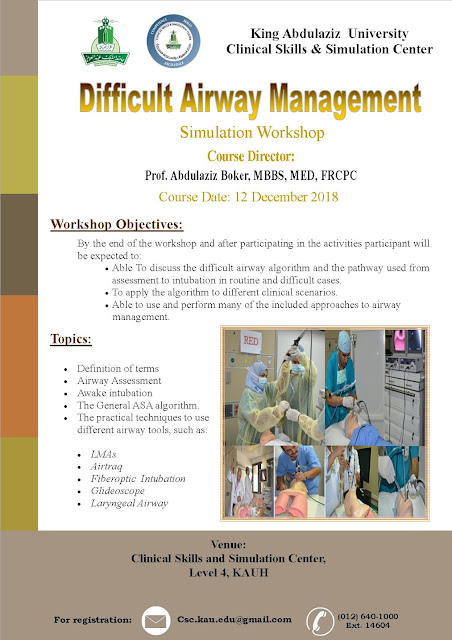About The Center
About the Center
 The Clinical Skills & Simulation Center (CSSC) at King Abdulaziz University (KAU) is a state of the art training center that can be used as a resource for specialized training of medical students, physicians, nurses, and other healthcare professionals. In the center, participants evaluate and diagnose patients through teaching models that incorporate the use of actor-patient and computerized manikin that simulate disease. CSSC provides opportunities for hands-on training a safe environment.
The Clinical Skills & Simulation Center (CSSC) at King Abdulaziz University (KAU) is a state of the art training center that can be used as a resource for specialized training of medical students, physicians, nurses, and other healthcare professionals. In the center, participants evaluate and diagnose patients through teaching models that incorporate the use of actor-patient and computerized manikin that simulate disease. CSSC provides opportunities for hands-on training a safe environment.
Summary
The CSSC feature includes:
1. Exam rooms, computer stations, and three wings, each has 8 rooms equipped exam room with computer stations.
2. One Simulated Operating Room.
3. One Simulated Trauma/Emergency Room.
4. Audio/Visual monitoring for each exam and simulation ER/OR rooms.
5. High fidelity computerized manikin (Hall, Istan, SimMan and Sim Baby).
6. Clinical stations/partial trainers (Trauma Man, Central Line trainers, IV arms, Arterial arms, Lumbar Puncture backs, Intubation heads, Pediatric Multi venous IV arm kit and Airway Management Trainer).
7. The b-line Medical Skills System and Sim Center System, comprehensive used for simultaneous monitoring, testing assessment, digital A/V management, and centralized data capture.
 8. A computer server system which
8. A computer server system whichprovides a range of outcome assessment activities including Objective Standardized Clinical Exercises (OSCE) for medical students, residents, faculty and other healthcare professionals. These include standardized patient encounters, high-fidelity mannequin scenarios, and clinical skills stations. The Clinical Skills Center is fully digitized which allows for the videotaping, video streaming, remote viewing and scoring of such simulated patient encounters.
9. We presently have standardized patients/actors as volunteers.
The Center offers a high degree of flexibility making it ideal for training courses tailored to provide education for the needs of a wide range of healthcare professionals and students, from refresher courses to tutorials or crisis re-enactments.
The Center offers a high degree of flexibility making it ideal for training courses tailored to provide education for the needs of a wide range of healthcare professionals and students, from refresher courses to tutorials or crisis re-enactments.
10. Simulation is used throughout the undergraduate curricula of Medicine, postgraduate and faculty (train the trainer). Simulation is introduced from the early stages of all curricula to reinforce and expand more formal models of teaching. The simulation teaching programmed in CSC is designed to increase in complexity to complement the students & doctors professional development. Simulation can be
classified as low fidelity (learning injection techniques on an artificial limb), medium fidelity (resuscitation training) or high fidelity (immersive simulation using SimMan 3G or Sim Baby.The Clinical Skills & Simulation Center has a large resource of part-task trainers to complement teaching sessions, such as venepuncture arms and physical examination models. The center has a wide range of manikins from resuscitation training models through to SimMan 3G. SimMan 3G is an advanced high fidelity patient simulator which is completely wireless. This portability increases the range of medical conditions and scenarios that SimMan 3G can be used for. The Ward Simulation Exercise assesses a student’s ability to priorities competing for demands including scripted timed interruptions, make safe decisions and manage the care of patients in a realistic clinical environment to increase authenticity Simulated Patients are trained for each session.
CSSC Activities
1- Objective Structured Clinical Examinations (OSCEs): for all clinical departments for pre and postgraduates programs
2- Organization and Hosting of scheduled or elective Workshops and Course
3- Orientation: Internship orientation program for the final year medical students.
4- Courses and workshops for preparation & training of health care trainers by using the latest education technologies



Comments
Post a Comment